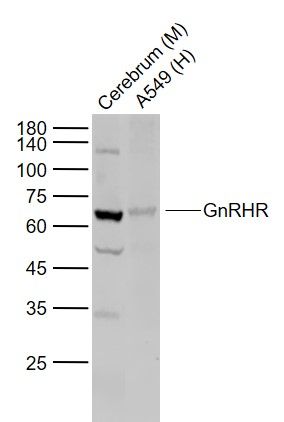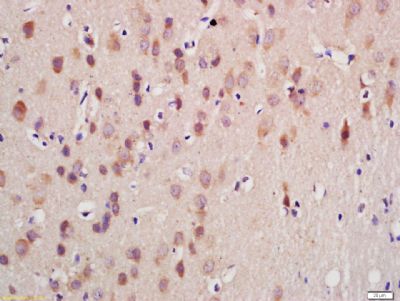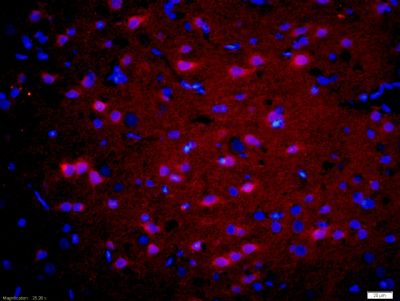Gonadotropin Releasing Hormone (GnRH) is down-regulated by hCG and believed to be an autocrine factor that regulates the ovary. The Gonadotropin Releasing Hormone Receptor (GnRHR) is synthesized in the pituitary gland. Activin A has been shown to stimulate the synthesis of GnRHR, illustrating a possible mechanism for the modulation of gonadotropin responsiveness to GnRH.
Function:
Receptor for gonadotropin releasing hormone (GnRH) that mediates the action of GnRH to stimulate the secretion of the gonadotropic hormones luteinizing hormone (LH) and follicle-stimulating hormone (FSH). This receptor mediates its action by association with G-proteins that activate a phosphatidylinositol-calcium second messenger system. Isoform 2 may act as an inhibitor of GnRH-R signaling.
Subcellular Location:
Cell membrane; Multi-pass membrane protein.
Tissue Specificity:
Pituitary, ovary, testis, breast and prostate but not in liver and spleen.
DISEASE:
Hypogonadotropic hypogonadism 7 with or without anosmia (HH7) [MIM:146110]: A disorder characterized by absent or incomplete sexual maturation by the age of 18 years, in conjunction with low levels of circulating gonadotropins and testosterone and no other abnormalities of the hypothalamic-pituitary axis. In some cases, it is associated with non-reproductive phenotypes, such as anosmia, cleft palate, and sensorineural hearing loss. Anosmia or hyposmia is related to the absence or hypoplasia of the olfactory bulbs and tracts. Hypogonadism is due to deficiency in gonadotropin-releasing hormone and probably results from a failure of embryonic migration of gonadotropin-releasing hormone-synthesizing neurons. In the presence of anosmia, idiopathic hypogonadotropic hypogonadism is referred to as Kallmann syndrome, whereas in the presence of a normal sense of smell, it has been termed normosmic idiopathic hypogonadotropic hypogonadism (nIHH). Note=The disease is caused by mutations affecting the gene represented in this entry.
Fertile eunuch syndrome (FEUNS) [MIM:228300]: Mild phenotypic form of HH going with the presence of normal testicular size and some degree of spermatogenesis. Note=The disease is caused by mutations affecting the gene represented in this entry.
Similarity:
Belongs to the G-protein coupled receptor 1 family.
SWISS:
P30968
Gene ID:
2798
Database links:
Entrez Gene: 403718 Dog
Entrez Gene: 2798 Human
Entrez Gene: 397515 Pig
Entrez Gene: 100009509 Rabbit
Omim: 138850 Human
SwissProt: Q9MZI6 Dog
SwissProt: P30968 Human
SwissProt: P49922 Pig
Unigene: 407587 Human
信号传导(Signaling Intermediates)
Grb2是生长因子受体结合蛋白2,又称Ash蛋白。该蛋白参与细胞内各种受体激活后的下游调节。能够直接与激活的表皮生长因子受体磷酸化的酪氨酸结合,参与EGF受体介导的信号转导, 属SH蛋白.
| Picture |
Sample:
Lane 1: Cerebrum (Mouse) Lysate at 40 ug
Lane 2: A549 (Human) Cell Lysate at 30 ug
Primary: Anti-GnRHR (SL1464R) at 1/1000 dilution
Secondary: IRDye800CW Goat Anti-Rabbit IgG at 1/20000 dilution
Predicted band size: 62-70 kD
Observed band size: 63 kD
Tissue/cell: rat brain tissue; 4% Paraformaldehyde-fixed and paraffin-embedded;
Antigen retrieval: citrate buffer ( 0.01M, pH 6.0 ), Boiling bathing for 15min; Block endogenous peroxidase by 3% Hydrogen peroxide for 30min; Blocking buffer (normal goat serum,SLC0005) at 37℃ for 20 min;
Incubation: Anti-GnRHR Polyclonal Antibody, Unconjugated(SL1464R) 1:200, overnight at 4°C, followed by conjugation to the secondary antibody(SP-0023) and DAB(SLC0010) staining
Tissue/cell: rat brain tissue;4% Paraformaldehyde-fixed and paraffin-embedded;
Antigen retrieval: citrate buffer ( 0.01M, pH 6.0 ), Boiling bathing for 15min; Blocking buffer (normal goat serum,SLC0005) at 37℃ for 20 min;
Incubation: Anti-GnRHR Polyclonal Antibody, Unconjugated(SL1464R) 1:200, overnight at 4°C; The secondary antibody was Goat Anti-Rabbit IgG, Cy3 conjugated(SL0295G-Cy3)used at 1:200 dilution for 40 minutes at 37°C. DAPI(5ug/ml,blue,SLC0033) was used to stain the cell nuclei
|
|
|


